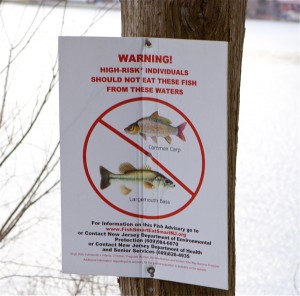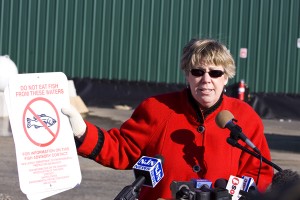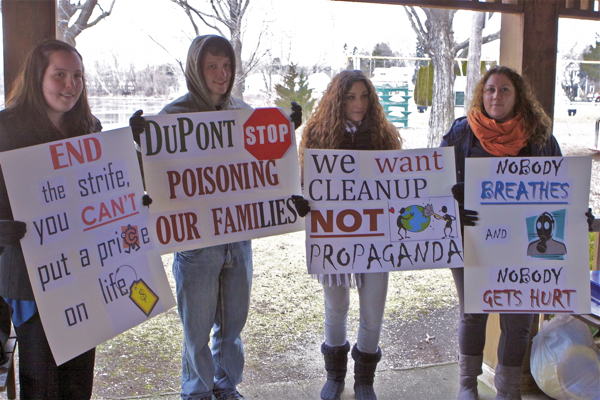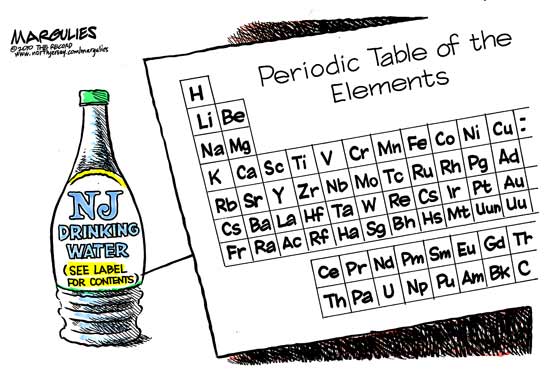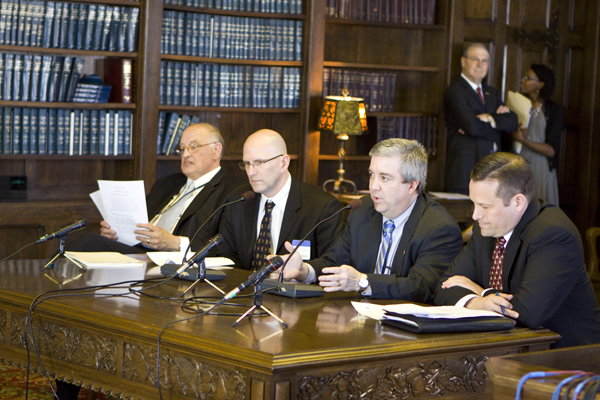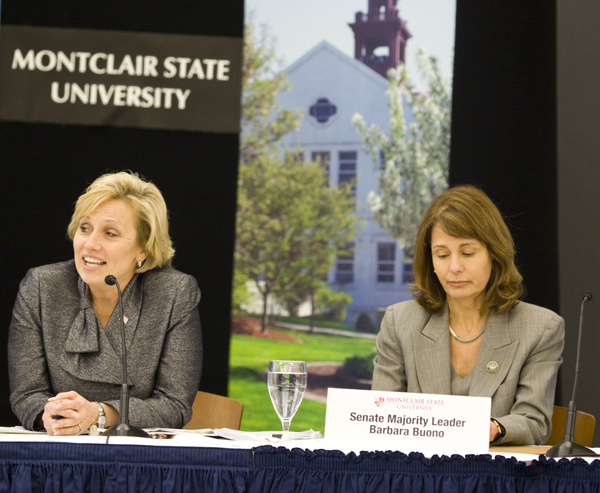Southwestern NJ in Drought Emergency
DEP Scientists Quietly Classify Groundwater Conditions as “Extremely Dry”
Where Are DEP Mandatory Water Use Restrictions & Conservation Measures?
[Update #2 – Imagine that, the groundwater conditions just happen to be improving, and DEP’s latest Aug 5 assessment goes out of tis way to show arrows pointing that out (something I don’t recall ever seeing)
I think I’ll file OPRA’s to get the underlying data and analysis supporting these assessments – Isn’t my skepticism of these “coincidental” improvements an indicator of DEP’s loss of scientific credibility? That’s what happens when you fudge the data analysis. end update#2]
Update: most recent July 29 DEP assessment – more regions of the state with severe dry stream flow and groundwater conditions – southwestern NJ “improves” somewhat. I would love to see the technical explanation for that – I suspect manipulation in response to the original post. New assessments should be posted on Monday August 6. end update]
DEP scientists recently classified groundwater conditions in southwestern NJ as “extremely dry” the equivalent of a drought “emergency” for areas reliant on groundwater (see green area in map above for impacted area).
I have some question for DEP based on that science – 8 specific questions.
1. Are residents in Mercer, Burlington, Camden, Cumberland, Gloucester and Salem Counties aware of that serious problem?
2. Why is drought status “normal” if groundwater conditions are “extremely dry”? (and rainfall and stream flow are well below normal too).
3. Have mandatory water use restrictions and water conservation measures been imposed for businesses and homes that use groundwater? If not, why not?
Or will people find out only after wells start to run dry?
4. Has DEP completely abdicated its responsibilities to plan for water supplies and to take the lead in drought management, as mandated by the NJ Water Supply Management Act? That law mandates:
The department shall prepare and adopt the New Jersey Statewide Water Supply Plan, which plan shall be revised and updated at least once every five years.
[Note: If case DEP forgot or needs guidance, see this:
NJSA 58:lA-2. Legislative findings and declarations.
The Legislature finds and declares that the water resources of the State are public assets ofthe State held in trust for its citizens and are essential to the health, safety, economic welfare, recreational and aesthetic enjoyment, and general welfare, of the people of New Jersey; that ownership ofthese assets is in the State as trustee ofthe people; that because some areas within the State do not have enough water to meet their current needs and provide an adequate margin of safety, the water resources of the State and any water brought into the State must be planned for and managed as a common resource from which the requirements ofthe several regions and localities in the State shall be met; that the present regulatory system for these water resources is ineffective and counterproductive; that it is necessary to insure that within each basin there exist adequate water supplies to accommodate present and future needs; that to ensure an adequate supply and quality of water for citizens of the State, both present and future, and to protect the natural environment of the waterways of the State, it is necessary that the State, through its Department of Environmental Protection, have the power to manage the water supply by adopting a uniform water diversion permit system and fee schedule, a monitoring, inspection and enforcement program, a program to study and manage the State’s water resources and plan for emergencies and future water needs, and regulations to manage the waters of the State during water supply and water quality emergencies.
5. Or has DEP privatized those responsibilities and functions, allowing private water companies to take charge, as in the recent Monmouth County disaster and water emergency caused by a major pipeline break?
6. Or has DEP delegated those responsibilities to local and county government – or outsourced them to corporate dominated private “sustainability” cover groups – as they did in the Monmouth emergency? (see DEP website for the highly unusual reliance on County government and private water company). Does DEP think posting a county press release on the DEP website satisfies their responsibility under the Act?
| July 1, 2012 | State of Emergency Still in Effect in Monmouth County; Strict water conservation measures remain in effect; Boil water advisory reduced to 4 towns; all outdoor use banned (Monmouth County Press Release) |
| June 30, 2012 | State of Emergency Still in Effect for Monmouth County; Strict Water Conservation Measures Remain Saturday; Boil Water Advisory Reduced to 22 Towns; All Outdoor Use Banned (Monmouth County Press Release) |
| June 29, 2012 | State of Emergency Declared in Monmouth County; Strict Water Conservation Measures Put in Place; All Outdoor Use Banned; Boil Water Advisory Expands to Entire County (Monmouth County Press Release) |
7. Where is the long overdue update to the Statewide Water Supply Master Plan? Why has DEP scrubbed its website regarding the prior plan? (which used to have these links:
WATER SUPPLY PLANNING |
|
| New Jersey Statewide Water Supply Plan (Pdf Format) Planning document for water supply |
August 1996 |
| New Jersey Statewide Water Supply Plan Appendices (Pdf Format) Planning document for water supply |
August 1996 |
| New Jersey Statewide Water Supply Plan Executive Summary (Pdf Format) Planning document for water supply |
August 1996 |
| New Jersey Statewide Water Supply Plan Map | |
That Plan would address these critical issues.
8. Where is the press corps, especially as we experience extreme weather record heat waves and drought conditions? Who will tell the people?
[Note: here are DEP powers and responsibilities:
58:1A-4. State of water emergency; emergency water supply allocation plan; powers ofGovernor and Commissioner; orders; review.
a. Upon a finding by the commissioner that there exists or impends a water supply shortage of a dimension which endangers the public health, safety, or welfare in all or any part of the State, the Governor is authorized to proclaim by executive order a state of water emergency. The Governor may limit the applicability of any state of emergency to specific categories of water supplies or to specific areas ofthe State in which a shortage exists or impends.
b. The department shall, within 180 days of the effective date of this act, adopt an Emergency Water Supply Allocation Plan as a rule and regulation. This plan shall be utilized as the basis for imposing water usage restrictions during a declared state of water emergency and shall include a priority system for the order in which restrictions would be imposed upon the various categories ofwater usage.
c. During the duration ofa state ofwater emergency the commissioner, to the extent not in conflict with applicable Federal law or regulation but notwithstanding any State or local law or contractual agreement, shall be empowered to:
(1) Order any person to reduce by a specified amount the use of any water supply; to make use of an alternate water supply where possible; to make emergency interconnections between systems; to transfer water from any public or private system; or to cease the use of any water supply;
(2) Order any person engaged in the distribution of any water supply to reduce or increase by a specified amount or to cease the distribution of that water supply; to distribute a specified amount of water to certain users as specified by the commissioner; or to share any water supply with other distributors thereof;
- (3) Establish priorities for the distribution ofany water supply;
- (4) Adopt rules and regulations as are necessary and proper to carry out the purposes of this section; and
(5) Direct any person engaged in the retail distribution of water to impose and collect a surcharge on the cost of that water as a penalty for the violation of any order to reduce water usage issued pursuant to this subsection. The disposition of all sums collected pursuant to this subsection shall be as provided by law; and
(6) Otherwise implement the Emergency Water Supply Allocation Plan adopted pursuant to subsection b. of this section.
Any order issued by the commissioner pursuant to this subsection shall be based upon fair compensation, reasonable rate relief and just and equitable terms, to be determined after notice and hearing which may occur subsequent to the order and compliance therewith.
d. During the existence of a state of water emergency, the Governor may order the suspension of any laws, rules, regulations, or orders of any department or agency in State Government or within any political subdivision which deal with or affect water and which impede his ability to alleviate or terminate a state ofwater emergency.
e. Any aggrieved person, upon application to the commissioner, shall be granted a review of whether the continuance of any order issued by the commissioner pursuant to this section is unreasonable in light of then prevailing conditions of emergency.
f. During a state of water emergency the commissioner may require any other department or other agency within State Government to provide information, assistance, resources, and personnel as shall be necessary to discharge his functions and responsibilities under this act, rules and regulations adopted hereunder, or applicable Federal laws and regulations….
58:1A-5. Supply and diversion of water; rules and regulations.
The commissioner shall have the power to adopt, enforce, amend or repeal, pursuant to the “Administrative Procedure Act,” P.L.1968, c. 410 (C. 52:14B-1 et seq.) rules and regulations to control, conserve, and manage the water supply of the State and the diversions of that water supply to assure the citizens of the State an adequate supply of water under a variety of conditions and to carry out the intent of this act. These rules and regulations may apply throughout the State or in any region thereof and shall provide for the allocation or the reallocation of the waters of the State in such a manner as to provide an adequate quantity and quality ofwater for the needs ofthe citizens of the State in the present and in the future and may include, but shall not be limited to:
a. A permit system to allocate or reallocate any or all of the waters of the State, which system shall provide for the issuance of permits to diverters ofmore than 100,000 gallons per day of the waters ofthe State, containing at a minimum the conditions required by this act;
b. Standards and procedures to be followed by diverters to ensure that:
- (1) Proper methods are used to divert water;
- (2) Only the permitted quantity of water is diverted and that the water is only used for its permitted purpose;
(3) The water quality of the water source is maintained and the water standards for the use ofthe water are met;
(4) The department is provided with adequate and accurate reports regarding the diversion and use ofwater;
c. Inspection, monitoring, reporting and enforcement procedures necessary to implement and enforce the provisions ofthis act;
d. Standards and procedures to be followed to determine the location, extent and quality of the water resources of the State and plan for their future use to meet the needs of the citizens ofthe State; …
58:1A-13. New Jersey Statewide Water Supply Plan.
a. The department shall prepare and adopt the New Jersey Statewide Water Supply Plan, which plan shall be revised and updated at least once every five years.
b. The plan shall include, but need not be limited to, the following:
(1) An identification of existing Statewide and regional ground and surface water supply sources, both interstate and intrastate, and the current usage thereof;
(2) Projections of Statewide and regional water supply demands for the duration of the plan;
(3) Recommendations for improvements to existing State water supply facilities, the construction of additional State water supply facilities, and for the interconnection or consolidation ofexisting water supply systems, both interstate and intrastate;
(4) Recommendations for the diversion or use of fresh surface or ground waters and saline surface or ground waters for aquaculture purposes;
(5) Recommendations for legislative and administrative actions to provide for the maintenance and protection ofwatershed areas;
(6) Identification of lands purchased by the State for water supply facilities that currently are not actively used for water supply purposes, including, but not limited to, the Six Mile Run Reservoir Site, with recommendations as to the future use of these lands for water supply purposes within or outside ofthe planning horizon for the plan; and
(7) Recommendations for administrative actions to ensure the protection of ground and surface water quality and water supply sources. …
58:1A-13.3. Preparation, adoption of revisions, updates to New Jersey Statewide Water Supply Plan.
a. The department shall prepare and adopt appropriate revisions and updates to the current New Jersey Statewide Water Supply Plan no later than December 31, 2006 pursuant to the provisions of section 13 ofP.L.1981, c.262 (C.58:1A-13). …
58:1A-14. Inadequate supply available to water purveyor; order for development or acquisition; certification of amount in local budget.
a. When the department determines that the developed water supply available to a water purveyor is inadequate to service its users with an adequate supply ofwater under a variety of conditions, the department may order the water purveyor to develop or acquire, within a reasonable period oftime, additional water supplies sufficient to provide that service. …
58:1A-15. Powers and duties.
[a-d]
e. Order the interconnection of public water supply systems, whether in public or private ownership, whenever the department determines that the public interest requires that this interconnection be made, and require the furnishing ofwater by means ofthat system to another system, but no order shall be issued before comments have been solicited at a public hearing, notice of which has been published at least 30 days before the hearing, in one newspaper circulating generally in the area served by each involved public water supply system, called for the purpose ofsoliciting comments on the proposed action.
f. Order any person diverting water to improve or repair its water supply facilities so that water loss is eliminated so far as practicable, safe yield is maintained and the drinking water quality standards adopted pursuant to the “Safe Drinking Water Act,” P.L.1977, c.224 (C.58:12A-1 et al.) are met; …
58:1A-16. Violations of act; remedies.



